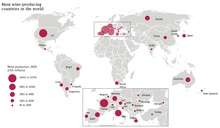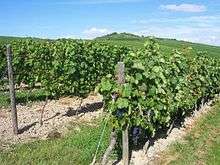Wine
As wine is usually regarded as the most sophisticated of alcoholic beverages, wine tourism or enotourism is highly developed in many regions around the world, and it can be as simple as hopping on a wine shuttle in Napa Valley or as complicated as renting a villa in the south of France for a month. Enotourism is a great way to learn about the people, culture, heritage, and customs of an area. Some of the famous wine producing regions of the world have been producing wine for centuries or even millennia, and the production and consumption of wine is deeply ingrained in the local culture. Also, these areas tend to be off the beaten tourist track (although not that far off) so enotourism can expose travelers to new and interesting areas. Getting out and visiting wine producers provides contact with local farmers and artisans who care deeply about the area. Wine growers are farmers, and their perspective on the local area, and life in general, tends to be different from other locals typically encountered while traveling.
For the oenophile, enotourism is a wonderful way to better understand terroir, the difficult to define concept that wine makers often use to describe a key component of their art. Roughly speaking, it has to do with how the quality of the land in which the grapes are grown affects the taste of the wine. Tasting wine at a wine shop or in the comfort of home can provide a hint at the terroir that produced the wine. But spending several days visiting the area, chatting with the wine makers and growers, and eating the local cuisine (which has evolved together with the wine for the two to perfectly complement each other) will provide an exceptional context for the wine and give deep insight into why and how the wine turned out the way it did.
See and do
| “ | Wine is bottled poetry. | ” |
—Robert Louis Stevenson | ||
The heart of enotourism is visiting wineries, and of course, tasting the wines.
Learn
One of the best ways to begin an adventure in enotourism is to attend wine classes at a respectable Wine School. There are several across the United States, with notable ones being the Chicago wine school, the International Wine Center in New York, and the Wine School in Philadelphia. In Australia, there is the National Wine Centre in Adelaide, which does wine research and also provides classes on wine appreciation.
Destinations

Europe
Bulgaria
- Moesia Danube plains Gamza
- Black sea coast Euxinograd wines
- Rose Valley Rossato
- Tracian plains Mavrud
- Struma Valley Broad Melnik vine
Cyprus
Not only does winemaking on the Mediterranean island of Cyprus date back more than 5,000 years, but it has some of the prettiest high-altitude vineyards in all the world. Accommodation costs are particularly cheap by European standards in the north.
Czech Republic
- Mutenice Wine Region
France
- See also: French cuisine
France is a traditional wine-growing country, with several very famous wine-growing regions, including the following:
- Alsace; see Alsatian Vineyard Route
- Burgundy
- Bordeaux
- Champagne
- Languedoc-Roussillon
- Loire Valley
- Provence
Many vineyards welcome visitors for wine-tastings.
Georgia
Georgia and Moldova were renowned in the former USSR as the republics where great wine came from. As an independent country, Georgia's wines have had some wider distribution, some of it intercontinental.
Germany

Germany is better known as a beer-making country, but it is also famous for its wines, especially the Rieslings of the Rhineland-Palatinate.
- Rheinhessen: Müller-Thurgau, Riesling, Dornfelder, Silvaner, Portugieser, Kerner, Spätburgunder, Grauburgunder, Scheurebe
- Palatinate: Riesling, Dornfelder, Müller-Thurgau, Portugieser, Spätburgunder, Kerner, Grauburgunder, Weißburgunder
- Baden: Spätburgunder, Müller-Thurgau, Grauburgunder, Riesling, Weißburgunder, Gutedel
- Württemberg:Trollinger, Riesling, Schwarzriesling, Lemberger, Spätburgunder, Kerner
- Mosel:Riesling, Müller-Thurgau, Elbling, Kerner
- Franconia: Müller-Thurgau, Silvaner, Bacchus
- Nahe: Riesling, Müller-Thurgau, Dornfelder
- Rheingau: Riesling, Spätburgunder, Müller-Thurgau
- Saale-Unstrut: Müller-Thurgau, Weißburgunder, Silvaner
- Ahr: Spätburgunder, Riesling, Portugieser
- Saxony: Müller-Thurgau, Riesling, Weißburgunder
- Mittelrhein: Riesling, Spätburgunder, Müller-Thurgau
- Hessische Bergstraße: Riesling, Spätburgunder, Grauburgunder
Italy

- See also: Italian cuisine
As in France, wine is a traditional product in Italy. It is produced virtually everywhere in the country, and this means no matter where you are going, you can combine your next trip to Italy with a bit of enotourism.
That said, if you're going specifically for the wine, there are some regions that stand out. If you use the awards given by the Italian wine bible Vini d'Italia as an indication, the three regions where the best wine is produced are Piedmont, Tuscany and Lombardy. They all have one particularly important subregion. For Piedmont it is Langhe, where among others the wines of Barolo and Barbaresco are produced. For Tuscany it is Chianti together with the towns of Montalcino and Montepulciano. For Lombardy it is Franciacorta where the homonimous sparkling wine is produced.
Enotourism is highly evolved in Italy, and many producers offer other services as well. Of particular importance is the agriturismo system of providing accommodation for tourists at the estate, making it easy to explore the surrounding region.
The event of Cantine Aperte on the last Sunday of May is a good opportunity for anyone interested in Italian wine. This is the day many wine producers throughout Italy open their doors for a free tasting of their wines.
Apulia (Puglia), in the south of Italy, is recently emerging for its wines and land. More information can be found on the Institutional Website ViaggiareinPuglia.it. Rome's Enotourism is also increased; the Roman Hills and Frascati are most enjoyable places.
- Sicillia Nero di Avola, Marsala
Moldova
Most of this country is a wine-growing area.
Spain
- La Rioja (Spain)
- Jerez de la Frontera - Famous for its sherry wines
Switzerland
The French-speaking part of the country, especially the canton of Valais and the region around Lake Geneva, is Switzerland's main wine producing area. The wine-growing terraces of Lavaux, with a history of viticulture since Roman times, are on UNESCO's World Heritage List.
Turkey
- Bozcaada (Tenedos) — known for its wine for centuries (so much so that the local coins depicted grapes in ancient times), this Aegean island off the western coast still keeps the tradition
- Cappadocia — some of the best wines Turkey has to offer come from the volcanic sands of Cappadocia
- Şarköy District — also known as the Thracian wine coast, this 35-km stretch of hilly land fronting the Sea of Marmara supplies about half of the country's wine production. Major wineries in the district, as well as others in the surrounding region, are connected to each other by the Thracian Wine Route.
- Şirince — this pleasant historic village is famous for its homemade wines, as well as fruit flavored ones
North America
Canada
- Okanagan Valley, British Columbia
- Niagara Region, Ontario - Particularly known for ice wines, the most famous brand being Inskillin.
- On a smaller scale, Prince Edward County in Ontario and the Eastern Townships in Québec
USA
- Colorado's Wine Country, Colorado
- Finger Lakes, New York
- Livermore, California
- Loudoun County, Virginia
- Napa Valley, California
- North Fork of Long Island, New York
- Pleasanton, California
- Russian River, California
- Sonoma County, California
- Swan Creek, North Carolina
- Walla Walla in the Columbia River Plateau of Washington
- Willamette Valley, Oregon
- Yadkin Valley, North Carolina
Oceania
Australia
- Hunter Valley
- Albany
- Barossa Valley
- Clare Valley
- McLaren Vale
- Mornington Peninsula
- Yarra Valley
- Margaret River
- Swan Valley
- Coonawarra
New Zealand
- Marlborough
- Nelson: although industrial quantities of Sauvignon Blanc are produced in its easterly neighbour, the boutique wines of this spectacularly scenic area have won many gold medals in international competitions. Austrian Herman Seifried, of the eponymous winery, was one of the pioneers in the renaissance of New Zealand viticulture.
Other parts of the world
- Cape Winelands, South Africa
- Galilee, Israel
- Golan Heights, Israel
- Bekaa Valley, Lebanon
- Mendoza, Argentina
- Chile is the other major wine producer in South America
Stay safe
Wine has all the hazards of alcoholic beverages. Drinking water on the side might help against dehydration, and keep consumption at a modest level.
